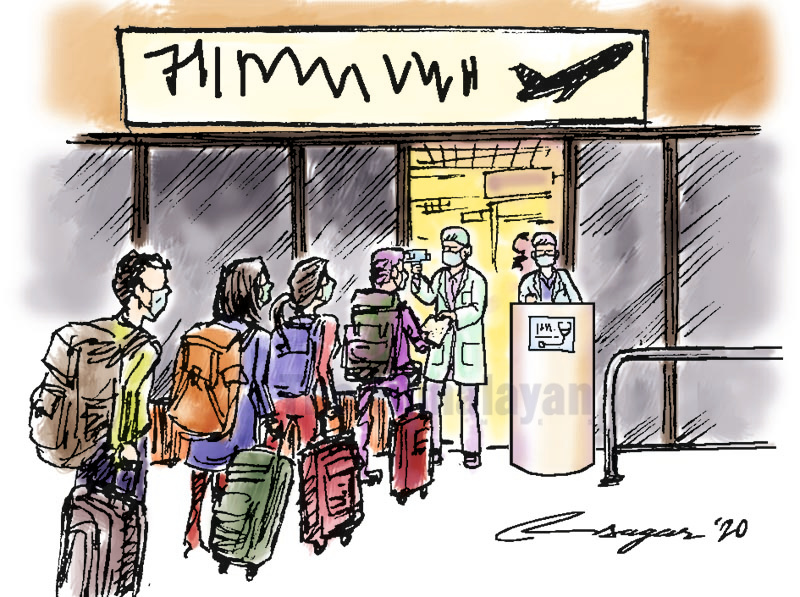Novel coronavirus scare: Boost surveillance at TIA
There is no need to panic over this novel coronavirus 2019-nCoV because its mortality rate is about 2 per cent, which is far less compared to the MERS and SARS coronaviruses. Nevertheless, we must not underestimate the potential of this virus
On January 13, a 31-yearold, previously healthy male was admitted to the Sukraraj Tropical and Infectious Disease Hospital (STIDH) after his return from Wuhan, China. He was suffering from fever and had difficulty breathing and cough. These symptoms are similar to those who died of pneumonia of an unknown origin in Wuhan. The causative agent of this mysterious pneumonia was later identified as the novel coronavirus, and scientifically denoted as “2019-nCoV”.
Wuhan city is believed to be the epicentre of the 2019-nCoV outbreak. According to media reports, 41 people have died due to its complications in China, and the number of infected people worldwide is said to have reached almost 1300.
With the celebration of 2020 as Visit Nepal Year and growing number of travellers to and from China, it is a wake-up call for Nepal to establish effective preparedness and response programmes against this novel coronavirus.
Coronaviruses are zoonotic, which cause illness ranging from a mild common cold to more severe diseases, such as Middle East Respiratory Syndrome coronavirus (MERS-CoV)) and Severe Acute Respiratory Syndrome coronavirus (SARS-CoV). MERS-CoV is mainly reported in the Middle East countries, Saudi Arabia in particular.
Dromedary camels are believed to be a major reservoir of this virus. The overall case fatality rate of MERS-CoV is approximately 35 per cent. Human-to-human transmission is possible but limited.
Middle East countries are a favourite destination for Nepali migrant workers, therefore, the risk of contracting this virus and spreading it to vulnerable people in Nepal is possible.
However, Nepal lacks testing equipment/kits or does not include it in a routine laboratory test. Even physicians do not consider this disease in the differential diagnosis.
In fact, reports show that every year thousands of patients die due to pneumonia of unknown origin in Nepal. A recent study conducted in Nepal showed that 8 per cent of infants (first 6 months of life), who experienced acute respiratory illness, suffered from human coronavirus.
It shows that human coronavirus is not a new disease in Nepal.
Another notable life-threatening coronavirus is known as SARS-CoV, which was first identified in 2002-2003 in Guangdong, China. It was reported in 37 countries across the world, infecting more than 8,000, resulting in 774 deaths. During that time, I was working as a medical officer at the STIDH and had been involved in the investigations of several suspected SARS-CoV patients carried out by the hospital.
Genetic sequencing of this novel coronavirus virus shows homology of only 73 per cent to SARS-CoV, meaning this novel coronavirus “2019-nCoV” is genetically distinct from existing human coronaviruses. So far, its symptoms include mainly fever and difficulty in breathing, resulting in severe acute respiratory syndrome and even death.
A Nepali citizen, who returned from Wuhan, China, was kept under close observation at the STIDH, after displaying fever and difficulty in breathing. In fact, he showed these symptoms before his departure from Wuhan. It is fortunate that his chest x-ray showed no sign of pneumonia.
According to WHO case definition, it can be regarded as a suspected case of novel coronavirus 2019- nCoV. Usually cough triggers breathing difficulties, but conversely, he complained of cough followed by difficulty in breathing.
He denied having visited any seafood or live animal market in Wuhan, indicating that this virus may have the capability to spread from human to human. In fact, very recently, the health authority in China confirmed human-to-human transmission, revealing 14 cases of transmission to healthcare providers, prompting hospital staff safety concerns.
To date, Thailand, Japan, South Korea, Taiwan and the US have reported imported cases of 2019-nCoV in their respective countries.
However, no casualties related to this virus have been reported. Many countries are stepping up measures, such as strengthening the surveillance system at their ports of entry to prevent 2019- nCoV from entering their respective countries.
Nepal, being a close neighbour of China, must step up a screening process at the Tribhuvan International Airport (TIA). A health desk was set up at the airport during the Ebola epidemic in Africa. It has, however, not been fully functioning as it lacks the required human resource, high-tech support, such as thermal scanners, and limited space and infrastructure.
Such resources are most urgent and must be made available as early as possible because WHO is expected to declare this novel coronavirus 2019- nCoV, as a Public Health Emergency of International Concern.
At present, there is no need to panic over this novel coronavirus 2019-nCoV because its mortality rate is approximately 2 per cent, which is far less compared to the MERS and SARS coronaviruses. Nevertheless, we must not underestimate the potential of this virus, because, at this moment,very little is known about this virus.
In another words, it is still unclear about its exact origin, behaviour, spectrum of disease, dynamic transmission, morbidity and mortality rate, and, more importantly, its possible consequences for Nepal.
Dr Pun is Chief, Clinical Research Unit, STIDH






